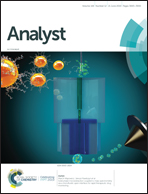The effect of dielectrophoresis on living cells: crossover frequencies and deregulation in gene expression
Abstract
This article documents the effect of dielectrophoresis on living cells. Given the longer duration procedures performed on microfluidic platforms, the influence of electric fields of high intensity may be of interest in manipulations other than dielectrophoresis. The crossover frequencies of several cell lines were experimentally determined using a microfluidic device. The crossover frequencies are investigated at different medium conductivities for red blood cells, white blood cells-Jurkat, 92.1 and OCM melanoma, and MDA-MB-231 breast cancer cell lines. The effect of dielectrophoresis on the cells at the gene level was also investigated by studying the alteration in gene expressions using microarray analysis. The alterations in genes due to the manipulation of cells at 10 kHz and 100 kHz with a sinusoidal 10 V peak signal for 60 minutes are explored. The two frequencies correspond to negative and positive dielectrophoresis, respectively. The cell line MDA-MB-231 is used as a model for studying the genes in this work. The dielectrophoresis was found to alter genes related to apoptosis, rRNA transcription, cellular respiration, energy production, cellular transcriptional activity, and other cellular functions.



 Please wait while we load your content...
Please wait while we load your content...